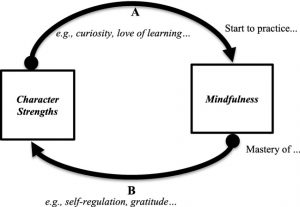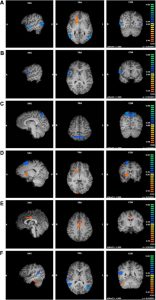Strengthen Character with Mindfulness
By John M. de Castro, Ph.D.
“Mindfulness opens the door to who we are, and character strengths are what is behind that door.” – Ryan Niemiec
Personality characteristics are thought to be relatively permanent traits that form an individual’s distinctive character. Engaging in mindfulness training has been shown to have a large number of beneficial effects on the psychological, emotional, and physical health of the individual and is helpful in the treatment of mental and physical illness. It also appears to be associated with healthy personality characteristics. Character strengths are group of positive personality characteristics that are highly valued such as “creativity, curiosity, open-mindedness, love of learning, perspective, bravery, perseverance, zest, love, social intelligence, forgiveness, self-regulation, appreciation of beauty, gratitude, hope, and spirituality.” This suggests that mindfulness may be associated with and may improve these character strengths.
In today’s Research News article “The Mutual Support Model of Mindfulness and Character Strengths.” (See summary below or view the full text of the study at: https://www.ncbi.nlm.nih.gov/pmc/articles/PMC6647542/), Pang and Ruch recruited participants online and had them complete an online questionnaire measuring mindfulness and 24 character strengths. They found that the higher the mindfulness scores the higher the character strengths. They then separated the participants in those who meditated and those who didn’t. They found that the meditators had significantly higher levels of mindfulness, and the character strengths of spirituality, gratitude, appreciation of beauty, curiosity, love of learning, curiosity, hope, bravery, leadership, zest, perspective, self-regulation, and humor.
In a second study they recruited adults and randomly assignee them to a wait-list control condition or to receive Mindfulness-Based Stress Reduction (MBSR) program. The MBSR program consists of 8 weekly 2-hour group sessions involving meditation, yoga, body scan, and discussion. The participants are also encouraged to perform daily practice. They were measured before and after training and 1, 3, and 6 months later for mindfulness and the 24 character strengths. They found that in comparison to baseline and the wait-list controls, after training and the follow-up measures the participants who received MBSR training had significantly higher levels of mindfulness, love, appreciation of beauty, gratitude, spirituality, zest, and bravery.
The 2 studies suggest that mindfulness is associated with character strengths and increasing mindfulness with MBSR training produces enduring increases in the levels of these strengths. The character strengths that were most associated with mindfulness, hope, bravery, curiosity, social intelligence, zest, love, perspective, and gratitude, have been shown to be associated with greater life satisfaction. This underscores the contribution of mindfulness to psychological health and happiness.
So, strengthen character with mindfulness.
“The combination of practicing mindfulness with a focus on character strengths helps us to open the door to avenues to self growth. With improved awareness of our character strengths we can more easily overcome common obstacles that emerge when developing mindfulness and serve to “supercharge” both mindful living and formal mindfulness meditation.” – Susan Kuz
CMCS – Center for Mindfulness and Contemplative Studies
This and other Contemplative Studies posts are also available on Google+ https://plus.google.com/106784388191201299496/posts and on Twitter @MindfulResearch
Study Summary
Pang, D., & Ruch, W. (2019). The Mutual Support Model of Mindfulness and Character Strengths. Mindfulness, 10(8), 1545–1559. doi:10.1007/s12671-019-01103-z
Abstract
Objectives
Numerous studies have confirmed robust relationships between general well-being and mindfulness or character strengths, respectively, but few have examined associations between mindfulness and character strengths. Two studies were carried out to explore these relationships comprehensively in the framework of the Values in Action (VIA) classification of character strengths.
Methods
In study 1, participants (N = 1335) completed validated assessments of mindfulness and character strengths, and the relationship between the two was investigated in a broad online sample. In study 2, the effect of a mindfulness training on specific character strengths was investigated using a randomized-control design (N = 42).
Results
The results of study 1 confirmed positive relationships between mindfulness and character strengths and further identified a list of character strengths that might overlap with mindfulness—i.e., creativity, curiosity, open-mindedness, love of learning, perspective, bravery, perseverance, zest, love, social intelligence, forgiveness, self-regulation, appreciation of beauty, gratitude, hope, and spirituality. The findings of study 2 provided further support for the hypothesis that mindfulness training could help cultivate certain character strengths. Compared with participants in the waitlist control condition, those who attended an 8-week mindfulness-based training program showed significant increases in the strengths of love, appreciation of beauty, gratitude, and spirituality, and a trend toward significant increases in the strengths of zest and bravery.
Conclusions
The results provide initial evidence for a mutual support model of mindfulness and character strengths.
https://www.ncbi.nlm.nih.gov/pmc/articles/PMC6647542/









